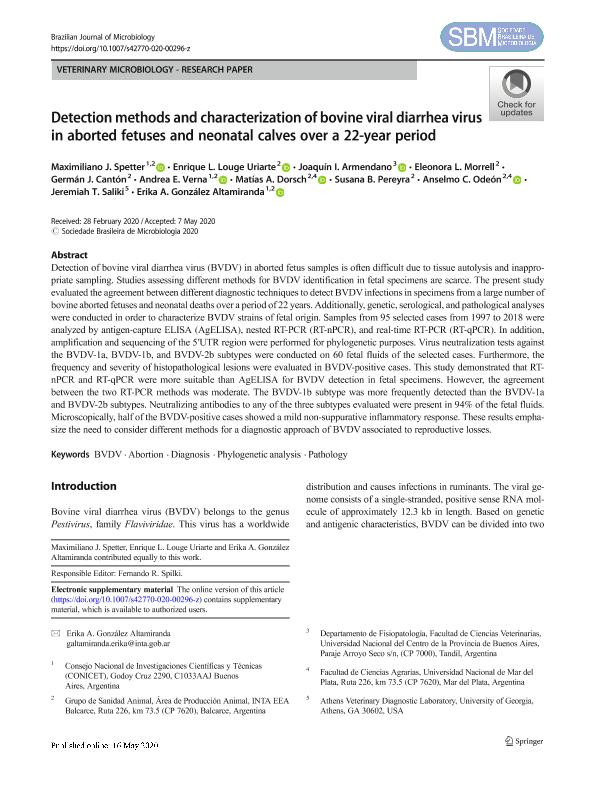Artículo
Detection methods and characterization of bovine viral diarrhea virus in aborted fetuses and neonatal calves over a 22-year period
Spetter Lucas, Maximiliano Joaquín ; Louge Uriarte, Enrique Leopoldo
; Louge Uriarte, Enrique Leopoldo ; Armendano, Joaquín Ignacio; Morrell, Eleonora Lidia
; Armendano, Joaquín Ignacio; Morrell, Eleonora Lidia ; Cantón, Germán J.; Verna, Andrea Elizabeth
; Cantón, Germán J.; Verna, Andrea Elizabeth ; Dorsch, Matías A.; Pereyra, Susana Beatriz; Odeón, Anselmo C.; Saliki, Jeremiah T.; González Altamiranda, Erika A.
; Dorsch, Matías A.; Pereyra, Susana Beatriz; Odeón, Anselmo C.; Saliki, Jeremiah T.; González Altamiranda, Erika A.
 ; Louge Uriarte, Enrique Leopoldo
; Louge Uriarte, Enrique Leopoldo ; Armendano, Joaquín Ignacio; Morrell, Eleonora Lidia
; Armendano, Joaquín Ignacio; Morrell, Eleonora Lidia ; Cantón, Germán J.; Verna, Andrea Elizabeth
; Cantón, Germán J.; Verna, Andrea Elizabeth ; Dorsch, Matías A.; Pereyra, Susana Beatriz; Odeón, Anselmo C.; Saliki, Jeremiah T.; González Altamiranda, Erika A.
; Dorsch, Matías A.; Pereyra, Susana Beatriz; Odeón, Anselmo C.; Saliki, Jeremiah T.; González Altamiranda, Erika A.
Fecha de publicación:
05/2020
Editorial:
Sociedade Brasileira de Microbiologia
Revista:
Brazilian Journal of Microbiology
ISSN:
1517-8382
e-ISSN:
1678-4405
Idioma:
Inglés
Tipo de recurso:
Artículo publicado
Clasificación temática:
Resumen
Detection of bovine viral diarrhea virus (BVDV) in aborted fetus samples is often difficult due to tissue autolysis and inappropriate sampling. Studies assessing different methods for BVDV identification in fetal specimens are scarce. The present study evaluated the agreement between different diagnostic techniques to detect BVDV infections in specimens from a large number of bovine aborted fetuses and neonatal deaths over a period of 22 years. Additionally, genetic, serological, and pathological analyses were conducted in order to characterize BVDV strains of fetal origin. Samples from 95 selected cases from 1997 to 2018 were analyzed by antigen-capture ELISA (AgELISA), nested RT-PCR (RT-nPCR), and real-time RT-PCR (RT-qPCR). In addition, amplification and sequencing of the 5′UTR region were performed for phylogenetic purposes. Virus neutralization tests against the BVDV-1a, BVDV-1b, and BVDV-2b subtypes were conducted on 60 fetal fluids of the selected cases. Furthermore, the frequency and severity of histopathological lesions were evaluated in BVDV-positive cases. This study demonstrated that RT-nPCR and RT-qPCR were more suitable than AgELISA for BVDV detection in fetal specimens. However, the agreement between the two RT-PCR methods was moderate. The BVDV-1b subtype was more frequently detected than the BVDV-1a and BVDV-2b subtypes. Neutralizing antibodies to any of the three subtypes evaluated were present in 94% of the fetal fluids. Microscopically, half of the BVDV-positive cases showed a mild non-suppurative inflammatory response. These results emphasize the need to consider different methods for a diagnostic approach of BVDV associated to reproductive losses.
Palabras clave:
BVDV
,
ABORTION
,
DIAGNOSIS
,
PHYLOGENETIC ANALYSIS
,
PATHOLOGY
Archivos asociados
Licencia
Identificadores
Colecciones
Articulos (IPADS BALCARCE)
Articulos de INSTITUTO DE INNOVACIÓN PARA LA PRODUCCIÓN AGROPECUARIA Y EL DESARROLLO SOSTENIBLE
Articulos de INSTITUTO DE INNOVACIÓN PARA LA PRODUCCIÓN AGROPECUARIA Y EL DESARROLLO SOSTENIBLE
Articulos(CCT - MAR DEL PLATA)
Articulos de CTRO.CIENTIFICO TECNOL.CONICET - MAR DEL PLATA
Articulos de CTRO.CIENTIFICO TECNOL.CONICET - MAR DEL PLATA
Citación
Spetter Lucas, Maximiliano Joaquín; Louge Uriarte, Enrique Leopoldo; Armendano, Joaquín Ignacio; Morrell, Eleonora Lidia; Cantón, Germán J.; et al.; Detection methods and characterization of bovine viral diarrhea virus in aborted fetuses and neonatal calves over a 22-year period; Sociedade Brasileira de Microbiologia; Brazilian Journal of Microbiology; 51; 4; 5-2020; 2077-2086
Compartir
Altmétricas



